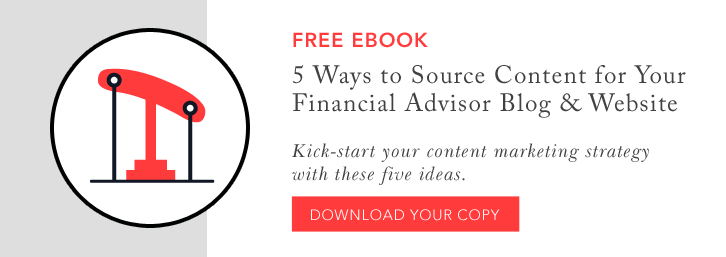

5 Types of Financial Website Content For Advisors
Content marketing for financial advisors, while not a new concept, is becoming more important than ever as websites are competing for investor's attention online. And while there is a large focus on creating those individual pieces of content (i.e. blog posts, videos, etc.) if it doesn’t fit together as part of your overall website content marketing strategy, you could be missing out on valuable SEO and site traffic.
So, what does this mean for financial advisors? When mapping out your overall content marketing strategy, if you don’t think of traffic to your website as your first priority, you need to start!
Your website is the foundation of all of your financial advisor digital marketing content and often is where people who click on any of your written assets are sent. As we’ve all seen from the changes in the world due to the global health crisis and subsequent economic effects, it’s important now more than ever to be able to communicate quickly and efficiently in an increasingly virtual world.
Read on for tips on the types of content and how to most effectively get your financial advisor content in front of your clients and prospects. Before you dive into the world of content marketing, let’s review the most common types of website content used by financial advisors.
Blog
Blogs are usually an extension of your website and are a very popular way to produce high-quality content marketing. Even a relatively short blog post can attract plenty of positive attention and traffic when using proper SEO tactics and taking full advantage of sharing on other channels.
Another growing practice is to also create long-form blog posts when taking a more detailed approach to a topic or current event. This may go against the previously held best practice of keeping blog posts brief – i.e. 1,000 words or less. In fact, these longer posts can achieve even greater SEO and ultimately hold your site in higher favor with Google.
White Papers and eBooks
Meant to be longer in nature, white papers and eBooks are meant to be multi-page resources on a topic in which the author is considered an expert, or at minimum very knowledgeable on a topic. For financial advisors, creating white papers and eBooks can be well worth the time and effort it takes to write them.
For one, you can place these resources behind a gate on your website, meaning that anyone interested in receiving a download to the asset has to provide their contact information and consent to being contacted at a later time. This means that anyone who accesses your white paper or eBook will now be someone on your contact list and will receive all of your future promotional emails and newsletters.
Email Newsletters
Speaking of email and newsletters, this is another type of content marketing that financial advisors can take advantage of to engage people on their website. By featuring content that directs the visitor to your website, you can increase both traffic and time on your website – both metrics that Google uses to determine the quality of a website.
A couple of tips for email marketing communications in general: 1) Make sure you’re using a marketing/email platform that helps you maintain your email list. Without this type of management in place, it’s nearly impossible to manage unsubscribes, click data, and much more. 2) Using personalized greetings in emails can greatly improve deliverability and open/click rates.
Video
While it can be more time consuming to script, shoot, and edit a video than it does to say, write a blog post – it can be well worth the effort. Content marketing via video is a great way to allow clients and prospective clients to get to know you and your financial advisor firm better. Even if you just produce a brief introduction video on the homepage of your website, you can gain plenty of traction and web traffic in the future.
Infographics
Infographics are the type of content that is highly shareable amongst social channels above all else. That’s because infographics are often used to convey large amounts of information, especially numbers and data. For financial advisors, this can be a great asset for explaining difficult concepts, market trends, or new laws or legislation that have passed and affect your clients.
Ways to Obtain or Create Content
If you’re on board with content marketing, but you aren’t sure if you have the time or resources to produce 100% original, sourced content – there are other ways to share content such as 3rd-party content and customizable content.
3rd Party Content is when you share something that another party produced and give your take or commentary on it, but still give full credit to the writer/ original source of the article and linking to that source. Oftentimes, sharing 3rd party content can result in a backlink – where another site links back to your website. Just be sure the content you’re sharing is not from a competitor or non-reputable source.
Customizable content is often the type of content where you take pre-written or “canned” content and can add your own logos, branding, and other personal touches that make the content align better with your firm and messaging. One thing to note: using all canned content can negatively impact your SEO.
That’s because this type of content is available to many other financial advisors who subscribe to that content. And if the same content comes up multiple times in Google’s crawling, it won’t give your website credit for “original” content. Now that doesn’t mean that you can’t/shouldn’t use it – simply that having a good mix of original, 3rd-party and customizable content will give your website both the visibility and credibility that a good content marketing plan can provide.
Remember, while content marketing on your website is meant to give your financial advisor firm an edge online, that doesn’t mean it should come at too much of a time sacrifice for you and your team. Partnering with a Digital Marketing agency that specializes in working with financial advisors can help reduce some of the time burden, while still allow you to do what you do best: talk to prospects and serve your clients.

Debbie Freeman
Search Here
Categories
- AI (18)
- blogging (2)
- branding (1)
- content (12)
- custodians (1)
- Digital (436)
- email marketing (3)
- fcmo (2)
- fees (1)
- financial advisor marketing (68)
- Google (3)
- Ideas & Tips (109)
- Investor Experience (7)
- lead generation (7)
- linkedin (1)
- Marketing (488)
- newsletters (1)
- Online Transparency (2)
- podcasting (1)
- search engine optimization (3)
- seo (9)
- Social Media (2)
- video (3)
- Websites (145)
- YouTube channel (2)
Recent Posts
-
 November 24, 2025
November 24, 2025 -

Top 5 Ways Digital Marketing Benefits Financial Advisors Seeking Leads
November 20, 2025 -

Trust Is The Biggest Online Marketing Challenge For Financial Advisors
November 17, 2025 -

Compliant Financial Advisor Bios Using AI Website Builders
October 22, 2025 -


